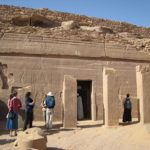
Temple of Beit el-Wali
The Temple of Beit el-Wali is a rock-cut Ancient Egyptian temple in Nubia which was built by Pharaoh Ramesses II and dedicated to the deities of Amun-Re, Re-Horakhti, Khnum and Anuket. It was the first in a series of temples built by Ramesses II in this region; its name Beit el-Wali means ‘House of the Holy Man’ and may indicate its previous use as by a Christian hermit at some point in time. The temple was relocated during the 1960s as a result of the Aswan High Dam project and moved towards higher ground along with the Temple of Kalabsha. This move was coordinated with a team of Polish archaeologists financed jointly by a Swiss and Chicago Institute respectively. The temple was located 50 kilometres south of Aswan.
The Nubian temples of Ramesses II (i.e. Wadi es-Sebua, Beit el-Wali and Abu Simbel), were part of a state sponsored policy designed to maintain Egyptian control over this area.[2] During the New Kingdom period of Egypt. “a deliberate policy of acculturation, Many leading Nubians were educated in Egypt and adopted Egyptian dress, burial customs and religion. They spoke the Egyptian language and even changed their names to Egyptian ones.
There is a large amount of original colour remaining in the inner part of this temple though the paint has disappeared from the historical scenes on its Forecourt. Near the middle of the south wall of the temple, Ramesses II is depicted charging into battle against the Nubians while his two young sons Amun-her-khepsef and Khaemwaset are shown being present in this relief scene. In the next relief scene,
“Ramesses [is] enthroned, receiving the tribute of Nubia. In the upper register, Ramesses’ eldest son and the viceroy Amenemope present the tribute procession. The viceroy is rewarded for his efforts with gold collars.
“A painted cast from a wall relief” in the Beit el-Wali temple then illustrates the wealth of exotic products which the Egyptians obtained in trade or tribute from the Kushites; here, the pharaoh receives “leopard-skins, giraffe tails, giraffes, monkeys, leopards, cattle, antelopes, gazelles, lions, ostrich feathers and eggs, ebony, ivory, fans, bowls, shields made of [animal] hides, and gold.”






